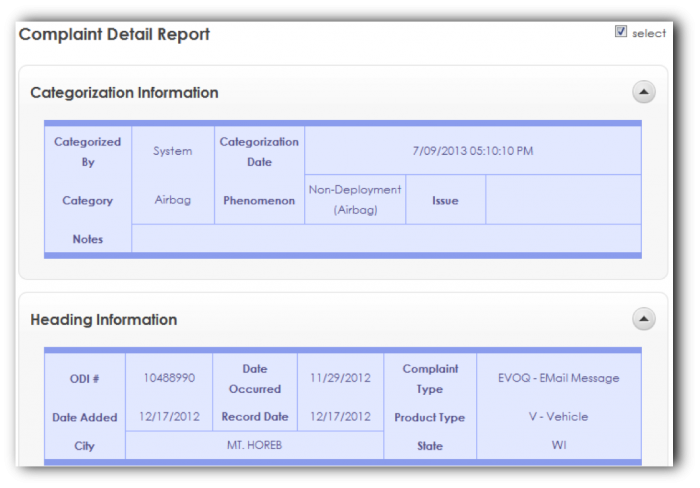Categorizing Complaints
Issue
NHTSA complaints data represents an extremely important data source for all manufacturers. Customer complaints are important to the manufacturers for multiple reasons, including customer feedback, product improvement, and so on…and that data might be used by NHTSA to initiate an investigation into an issue. It also allows them to benchmark the issues that are being faced by the other manufacturers in the automotive industry.
The manufacturers would love to be able to track the new complaints added by NHTSA on a daily basis. They would love the ability to read and categorize the complaints on a daily basis, in order to keep ahead of the issues and to be able to proactively address them.
Yet it is nearly impossible for manufacturers to achieve this goal, since NHTSA does not provide any way to track down what information is added in last day, or last three days, or the last x-number of days. To make matters worse, there is no mechanism for categorizing the information in a way that would it make it easy for the manufacturers to track, analyze, review and report on. The only solution would be for manufacturers to build a system from the ground up, which is a very costly proposition, as it would take a huge amount of time and money, not to mention the associated maintenance costs.
Or, they could plug in to the power of Datrato.
Datrato Solution
With Datrato’s custom complaints categorization capabilities, the user receives daily email alerts (See Figure 1 below), showing new complaints.

Figure 1: Daily Alert Email with link to the New Reports
Datrato users can view the complaints as detailed printable reports (See Figure 2), as well as download the data as a Comma Separated Values (CSV) file that can be imported into Excel, Access or any other database. To make things even simpler, Datrato sifts thru the text to categorize the complaints into NHTSA Early Warning Categories, based on unique text classification techniques. The user is provided a link to view the categorized report, where one can accept the categorization done by the system or choose to change categories (See Figure 3). Users can also assign phenomenon, issues and write textual notes associated with the complaint. A complaint can even be categorized into multiple categories—for example, an issue that could be related to brakes as well as structure.

Figure 2: Daily Detailed Categorized Report
Figure 3: Parameter Screen to Search on the Categorization Complaints
But the system doesn’t stop there, it even allows the user to search on the categorized information, including notes and categories, etc., to generate reports (See Figure 4). Through the power of Datrato, such a categorization task, which might otherwise take hours or even days, can be completed in minutes—saving users an enormous amount of time and money.

Figure 4: Parameter Screen to search on the Categorization Complaints
It’s practically real time…and it’s what we mean by “Data. Delivery. Intelligence.”—quicker and easier than you ever thought possible!

